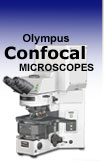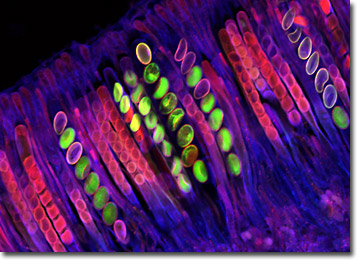 |
 |
 |
|
||||||||||||||||||||||||
 | ||||||||||||||||||||||||
 | ||||||||||||||||||||||||
 | ||||||||||||||||||||||||
Confocal Microscopy Image Gallery
Plant Tissue Autofluorescence Gallery
Cup Fungus
Some of the most eye-catching fungi in the forest are cup fungi, a large, colorful group of fungi with fruiting bodies that are cup or saucer shaped. Despite their relatively similar forms, cup fungi are extremely diverse, consisting of members from a number of different families and genera in the class Ascomycetes.

Cup fungi grow in a rainbow-like array of colors and from about a millimeter to hundreds of times that size in diameter. A variety commonly called the orange peel fungus (Aleuria aurantia), for instance, is a bright, citrus-hued fungus with a fruiting body that may measure as many as ten centimeters or more across, whereas the white or yellow Hymenoscyphus fructigenus cup fungus is so small that dozens of them may be seen on a single acorn or hickory shell.
The cup-like component of a cup fungus is termed the apothecium. It is the structure that bears the spores of the fungus in special elongated cases called asci. Eight ascospores are typically contained in each ascus. The curvature of many species of the fungi allows the ascospores to be readily released both by the wind and by the impact of raindrops. Some cup fungi are also capable of releasing the spores they contain by forcible discharge, in which case the spores are known as ballistospores.
Contributing Authors
Nathan S. Claxton, Shannon H. Neaves, and Michael W. Davidson - National High Magnetic Field Laboratory, 1800 East Paul Dirac Dr., The Florida State University, Tallahassee, Florida, 32310.
